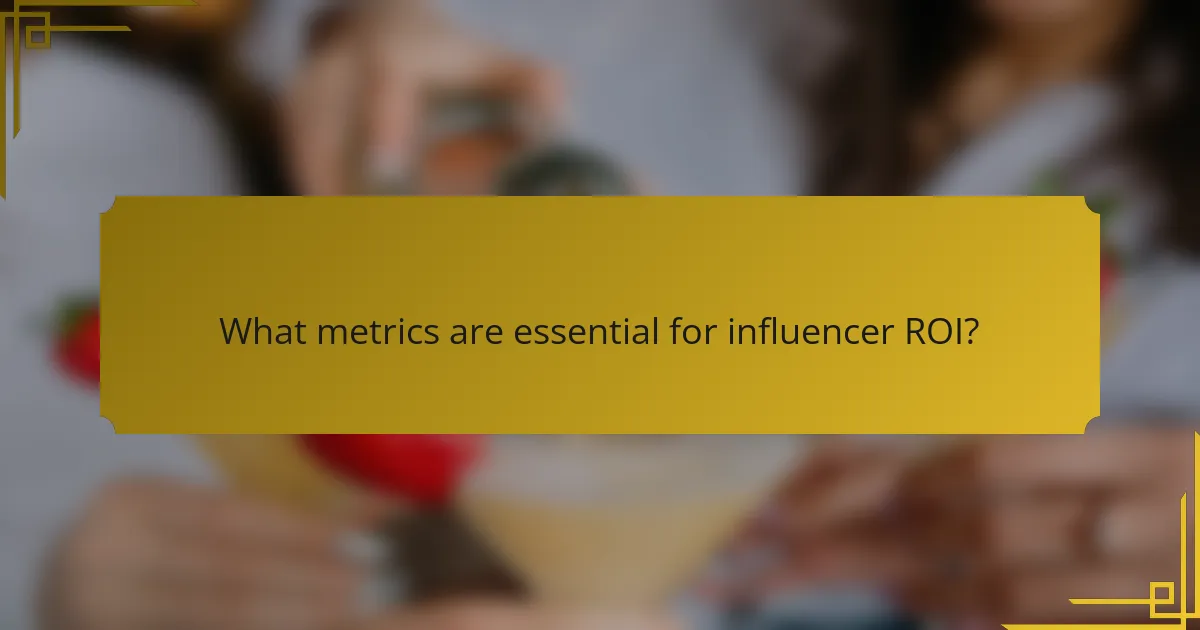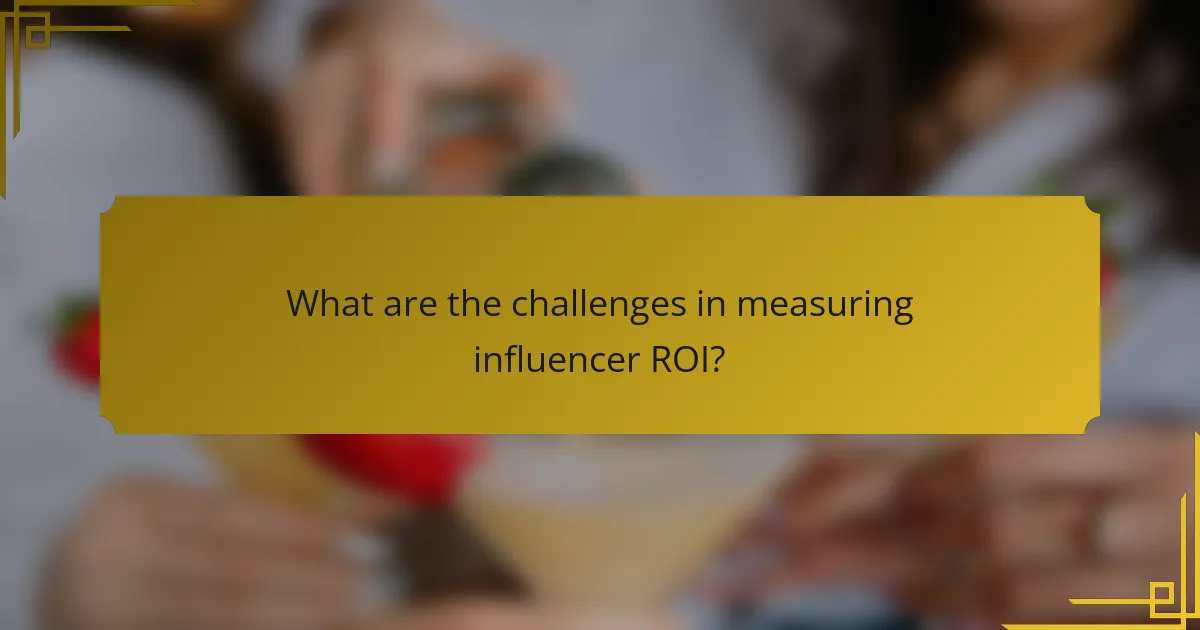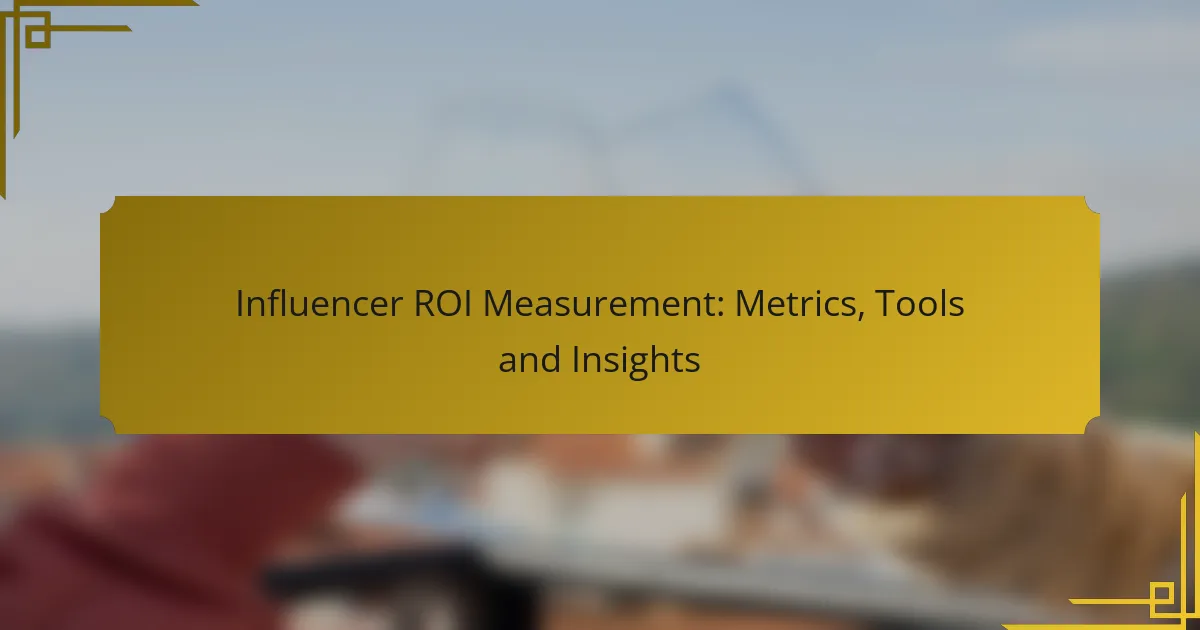Measuring influencer ROI is crucial for understanding the effectiveness of your marketing efforts and their alignment with business goals. By focusing on key metrics such as engagement, conversion rates, and brand awareness, brands can gain valuable insights into campaign performance. Utilizing specialized tools for analytics and reporting further enhances the ability to track and optimize influencer marketing strategies.

How to measure influencer ROI effectively?
Measuring influencer ROI effectively involves evaluating the impact of influencer marketing on your business goals. Key metrics such as engagement, conversion rates, brand awareness, and customer lifetime value provide insights into the effectiveness of your campaigns.
Use engagement metrics
Engagement metrics are crucial for assessing how well your audience interacts with influencer content. Key indicators include likes, shares, comments, and overall reach. High engagement often correlates with greater brand affinity and potential sales.
To effectively measure engagement, track these metrics across different platforms. For instance, Instagram may show higher engagement rates compared to Twitter, so adjust your expectations accordingly. Aim for engagement rates between 1% to 3% as a general benchmark.
Calculate conversion rates
Conversion rates indicate how many users take a desired action after interacting with influencer content. This could be making a purchase, signing up for a newsletter, or downloading an app. To calculate this, divide the number of conversions by the total interactions and multiply by 100 to get a percentage.
For example, if an influencer’s post generates 1,000 clicks and results in 50 purchases, the conversion rate would be 5%. Monitoring conversion rates helps you understand the effectiveness of your influencer partnerships in driving sales.
Analyze brand awareness
Brand awareness measures how well your target audience recognizes and remembers your brand. Influencer campaigns can significantly boost visibility, which can be tracked through surveys, social media mentions, and website traffic analysis. Consider using tools like Google Analytics to monitor referral traffic from influencer links.
Surveys can be particularly effective; ask customers how they heard about your brand before and after an influencer campaign. An increase in brand recall or recognition indicates a successful influencer strategy.
Track customer lifetime value
Customer lifetime value (CLV) estimates the total revenue a customer will generate during their relationship with your brand. Understanding CLV helps you assess the long-term impact of influencer marketing. To calculate CLV, multiply the average purchase value by the average purchase frequency and the average customer lifespan.
For example, if a customer spends $100 per purchase, makes 5 purchases a year, and stays with your brand for 3 years, the CLV would be $1,500. By comparing CLV before and after influencer campaigns, you can gauge their effectiveness in fostering customer loyalty and repeat business.

What metrics are essential for influencer ROI?
To effectively measure influencer ROI, focus on key metrics that reflect the impact of your campaigns. Essential metrics include reach, engagement rate, cost per acquisition, and return on ad spend, each providing insights into different aspects of performance.
Reach and impressions
Reach refers to the total number of unique users who see your content, while impressions indicate how many times your content is displayed, regardless of whether it was clicked. High reach and impressions suggest that your influencer’s audience is large and engaged, which is crucial for brand visibility.
When evaluating these metrics, consider the platform’s characteristics. For instance, Instagram may yield higher impressions due to its visual nature compared to a text-based platform like Twitter. Aim for a reach that aligns with your target audience size to ensure effective marketing.
Engagement rate
The engagement rate measures how actively the audience interacts with the content, typically calculated as the total interactions (likes, comments, shares) divided by the total reach or impressions. A higher engagement rate indicates that the audience finds the content relevant and compelling.
For influencers, an engagement rate of around 1% to 3% is generally considered average, while rates above 3% are often seen as strong. Monitor this metric closely to assess the effectiveness of your influencer partnerships and adjust strategies as needed.
Cost per acquisition
Cost per acquisition (CPA) calculates the total cost of acquiring a customer through influencer marketing. This metric helps you understand the financial efficiency of your campaigns by dividing total campaign costs by the number of conversions generated.
To optimize CPA, consider setting clear goals for your campaigns and tracking expenses meticulously. A reasonable CPA varies by industry but should ideally be lower than the average customer lifetime value to ensure profitability.
Return on ad spend
Return on ad spend (ROAS) measures the revenue generated for every dollar spent on advertising. This metric is crucial for assessing the overall effectiveness of influencer marketing efforts, as it directly correlates to profitability.
A common benchmark for ROAS is a ratio of 4:1, meaning for every $1 spent, $4 in revenue is generated. Regularly analyze ROAS to determine which influencers and campaigns yield the best financial returns, allowing for informed budget allocation in future initiatives.

Which tools assist in influencer ROI measurement?
Several tools can effectively assist in measuring influencer ROI by providing analytics, tracking, and reporting capabilities. These tools help brands assess the effectiveness of their influencer marketing campaigns through various metrics and insights.
HypeAuditor for analytics
HypeAuditor specializes in providing detailed analytics on influencer performance, audience demographics, and engagement rates. It uses AI to analyze millions of Instagram accounts, offering insights into authenticity and audience quality.
Brands can leverage HypeAuditor to identify potential influencers who align with their target audience, ensuring a better fit for campaigns. The platform also allows users to track performance metrics over time, helping to refine strategies based on real data.
Influencity for tracking
Influencity offers robust tracking features that enable brands to monitor influencer campaigns in real-time. This tool allows users to set specific KPIs and track metrics such as reach, impressions, and conversions, providing a comprehensive view of campaign performance.
With its user-friendly dashboard, brands can easily visualize data and make informed decisions. Influencity also supports collaboration among team members, facilitating streamlined communication and project management.
Sprout Social for reporting
Sprout Social excels in reporting capabilities, allowing brands to generate detailed reports on influencer marketing efforts. Users can customize reports to focus on key metrics, such as engagement rates and audience growth, making it easier to assess ROI.
This tool integrates with various social media platforms, providing a holistic view of campaign performance across channels. Brands can use Sprout Social to share insights with stakeholders, ensuring transparency and alignment on marketing goals.

What criteria should be considered when selecting measurement tools?
When selecting measurement tools for influencer ROI, consider integration capabilities, data accuracy, and user-friendly interfaces. These criteria ensure that the tools effectively track performance and provide actionable insights.
Integration capabilities
Integration capabilities refer to how well the measurement tools can connect with existing marketing platforms and social media channels. Tools that easily integrate with CRM systems, analytics platforms, and social media dashboards streamline data collection and analysis.
For example, a tool that connects with platforms like Google Analytics or Facebook Ads Manager can provide a comprehensive view of influencer performance. Look for tools that support APIs or offer pre-built integrations to enhance efficiency.
Data accuracy
Data accuracy is crucial for reliable ROI measurement. Tools should provide precise metrics on engagement, reach, and conversions to ensure that decisions are based on trustworthy information.
Consider tools that utilize verified data sources and have a reputation for accuracy. Regular audits and comparisons with industry benchmarks can help assess the reliability of the data being reported.
User-friendly interface
A user-friendly interface is essential for effective tool utilization. Tools should be intuitive, allowing users to navigate easily and access key features without extensive training.
Look for dashboards that present data visually and allow for customization. A well-designed interface can significantly reduce the time spent on data analysis, enabling quicker decision-making and strategy adjustments.

How do different industries approach influencer ROI measurement?
Different industries utilize various metrics and strategies to measure influencer ROI, reflecting their unique goals and target audiences. Understanding these approaches can help brands optimize their influencer marketing efforts and achieve better results.
Fashion industry metrics
The fashion industry often focuses on metrics like engagement rates, reach, and conversion rates to assess influencer ROI. Brands typically track how many followers engage with posts, the overall impressions generated, and the sales attributed to influencer campaigns.
Common tools include social media analytics platforms and affiliate marketing links that allow brands to monitor sales directly linked to influencer promotions. For example, a fashion brand might see a 15-20% increase in sales during a campaign with a popular influencer.
Technology sector strategies
In the technology sector, ROI measurement often emphasizes lead generation and customer acquisition costs. Companies may evaluate the number of leads generated from influencer content and the cost per acquisition to determine the effectiveness of their campaigns.
Tech brands frequently use specialized software to track user engagement and conversion metrics. For instance, a software company might find that a campaign with a tech influencer results in a 30% increase in trial sign-ups, providing a clear ROI metric.
Food and beverage insights
The food and beverage industry typically measures influencer ROI through metrics such as brand awareness, customer sentiment, and sales lift. Brands often assess how influencer partnerships affect consumer perceptions and purchasing behavior.
Tools like social listening platforms can help track mentions and sentiment analysis, while sales data can reveal the impact of influencer campaigns on product sales. For example, a beverage brand might observe a 10-15% increase in sales following a campaign featuring a well-known food influencer, indicating a successful ROI.

What are the challenges in measuring influencer ROI?
Measuring influencer ROI presents several challenges, primarily due to the complexity of tracking conversions and attributing sales directly to influencer campaigns. Factors such as varying audience engagement, platform algorithms, and the difficulty in isolating influencer impact from other marketing efforts complicate accurate measurement.
Attribution Issues
Attribution issues arise when trying to determine which specific influencer or campaign led to a conversion. With multiple touchpoints in a consumer’s journey, it can be challenging to pinpoint the exact source of engagement. Utilizing unique tracking links and promo codes can help clarify which influencers drive sales, but these methods may not capture the full picture.
Data Quality and Consistency
Data quality and consistency are crucial for accurate ROI measurement. Influencer marketing often relies on metrics from various platforms, which may not align in terms of definitions or reporting standards. Ensuring that data sources are reliable and comparable is essential for drawing meaningful insights.
Long-Term Impact Measurement
Measuring long-term impact is another challenge, as influencer marketing effects may extend beyond immediate sales. Brand awareness and customer loyalty can take time to manifest, making it difficult to assess the true value of an influencer partnership. Tracking metrics such as repeat purchases and customer lifetime value can provide a more comprehensive view of ROI over time.
Budget Constraints
Budget constraints can limit the ability to invest in sophisticated measurement tools or analytics. Smaller brands may struggle to allocate sufficient resources for comprehensive tracking and analysis. Prioritizing essential metrics and leveraging free or low-cost tools can help manage costs while still gaining valuable insights.
